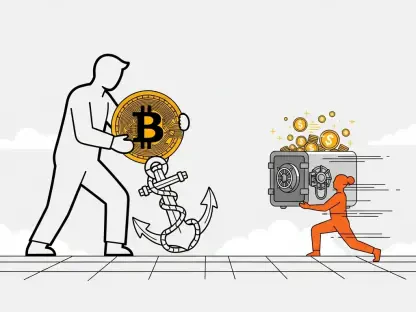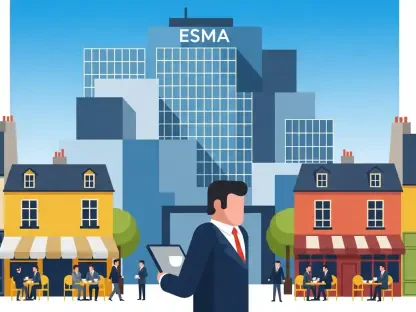Imagine a financial world where assets like bonds or money market funds are transformed into digital tokens on a blockchain, enabling near-instantaneous transactions and unprecedented efficiency. This vision of tokenization, powered by distributed ledger technology (DLT), is capturing the attention of global markets as a potential game-changer. A recent report by the International Organization of Securities Commissions (IOSCO) delves into this emerging trend, highlighting its capacity to streamline processes while also uncovering a host of challenges. From faster settlement times to improved collateral mobility, the allure of tokenization is undeniable, yet the path to widespread adoption remains fraught with obstacles. As financial institutions and regulators grapple with this innovation, the balance between harnessing its benefits and mitigating its risks becomes a critical focal point. This discussion aims to unpack the dual nature of tokenization, exploring how it could reshape markets while addressing the hurdles that stand in its way.
Unveiling the Potential of Digital Assets
The concept of tokenization offers a tantalizing glimpse into the future of finance, where traditional assets are digitized into tokens on a blockchain, facilitating seamless transactions across borders and systems. Proponents argue that this technology can significantly reduce settlement times, often cutting processes that take days into mere seconds, thereby enhancing market efficiency. Beyond speed, tokenization improves collateral mobility, allowing assets to be used more flexibly in various financial operations. The IOSCO report points to specific use cases, such as tokenized money market funds and fixed-income instruments, as early examples of how this innovation could transform investment landscapes. While the theoretical advantages are compelling, the reality of implementation reveals a more complex picture, with many market participants still tethered to conventional infrastructure. This slow shift underscores a broader hesitancy to fully embrace digital systems, despite the clear potential for operational improvements that could redefine financial interactions.
Moreover, the promise of tokenization extends beyond mere efficiency to potentially democratizing access to financial markets by lowering entry barriers for smaller investors through fractional ownership of high-value assets. This aspect could reshape investment dynamics, making previously inaccessible markets available to a wider audience and fostering inclusivity. However, the IOSCO findings caution that tangible benefits remain limited at this stage, as scalability issues persist. Interoperability between different blockchain platforms and the lack of reliable settlement assets are significant roadblocks that prevent tokenization from reaching its full potential. Market players often find themselves relying on hybrid systems that blend traditional and digital processes, diluting the transformative impact of the technology. As the financial sector navigates these early stages, the gap between theoretical gains and practical application highlights the need for robust solutions to bridge existing divides in infrastructure and trust.
Navigating the Risk Landscape
Despite its potential, tokenization introduces a spectrum of risks that, while familiar in nature, manifest uniquely in a digital context, posing fresh challenges to market stability. Legal uncertainties top the list, with questions surrounding the treatment of tokenized assets compared to their traditional counterparts, especially in terms of ownership rights and investor protections. Operational vulnerabilities are amplified when assets reside on shared blockchains, exposing them to cyber threats, transaction delays, data breaches, and flaws in smart contracts. The loss of private keys, a critical component for accessing digital assets, further compounds these concerns. The IOSCO report emphasizes that such risks, though not entirely new, require careful scrutiny due to their altered presentation in a blockchain environment. Addressing these issues demands a rethinking of existing safeguards to ensure they are fit for purpose in a rapidly evolving digital landscape.
Additionally, the interconnectedness of market participants on common blockchain platforms heightens the potential for systemic risks, creating ripple effects that could destabilize broader financial ecosystems. A notable concern is the integration of tokenized assets, such as money market funds, into crypto markets as reserve assets for stablecoins or collateral in transactions. This linkage introduces vulnerabilities that could amplify existing threats, particularly if disruptions in one sector spill over into others. The complexity of these interdependencies underscores the importance of proactive risk management strategies tailored to the unique characteristics of digital environments. While traditional frameworks provide a starting point, the distinct nature of blockchain-based systems necessitates innovative approaches to prevent cascading failures. As tokenization gains traction, vigilance in identifying and mitigating these interconnected risks will be paramount to maintaining market integrity.
Regulatory Challenges and Responses
From a regulatory standpoint, tokenization presents a diverse array of approaches among global authorities, reflecting the complexity of integrating this technology into existing frameworks without stifling innovation. Some jurisdictions have rolled out specific guidance to address digital assets, while others have opted for tailored exemptions or regulatory sandboxes to test new ideas in controlled environments. Despite these differences, a unifying theme emerges in the IOSCO report: the need for technology-neutral, principles-based standards that ensure consistent outcomes regardless of the tools involved. The mantra of “same activities, same risks, same regulatory outcomes” guides efforts to balance the promotion of innovation with the imperative of protecting investors and maintaining market stability. This approach seeks to create a level playing field where tokenization can flourish without undermining the foundational principles of financial oversight.
Furthermore, the evolving nature of tokenization calls for ongoing monitoring and adaptability among regulators to keep pace with technological advancements and emerging risks. The IOSCO report advocates leveraging existing digital finance standards as a baseline while remaining open to developing new controls specific to blockchain-related vulnerabilities. This dual strategy acknowledges that while many risks mirror those in traditional markets, their digital context often requires customized solutions. Regulators are encouraged to foster collaboration with industry stakeholders to better understand the practical implications of tokenization and refine oversight mechanisms accordingly. As market roles and infrastructure models shift in response to tokenized assets, maintaining a proactive stance will be essential to address legal ambiguities and operational fragilities. This dynamic regulatory landscape reflects a cautious optimism, striving to harness the benefits of digital innovation while safeguarding against potential pitfalls.
Shaping the Future of Tokenized Finance
Reflecting on the journey of tokenization, it becomes evident that while the technology holds immense promise for revolutionizing financial markets, its path is marked by significant challenges that demand careful navigation. The limited adoption witnessed so far, coupled with persistent reliance on traditional systems, highlights a cautious approach among market participants wary of untested digital frameworks. Legal uncertainties, operational weaknesses, and systemic interconnections pose substantial hurdles that test the resilience of existing safeguards. Regulators and industry players alike recognize the importance of sustained vigilance to manage both familiar and novel risks that emerge in this digital shift. The insights provided by comprehensive analyses, such as those in the IOSCO report, prove invaluable in framing the discourse around balancing innovation with stability during these formative stages.
Looking ahead, the next steps for tokenization involve fostering greater collaboration between regulators and the financial sector to develop frameworks that address technology-specific vulnerabilities while building on established principles. Prioritizing interoperability and reliable settlement mechanisms will be crucial to overcoming current barriers and driving broader adoption. Additionally, investing in robust cybersecurity measures and clarifying the legal standing of tokenized assets can help build trust among market participants. As the landscape continues to evolve, continuous dialogue and adaptive strategies will play a pivotal role in ensuring that the transformative potential of tokenization is realized without compromising market integrity. These actionable measures offer a roadmap for navigating the complexities of digital finance, setting the stage for a future where efficiency and security coexist harmoniously in tokenized markets.









